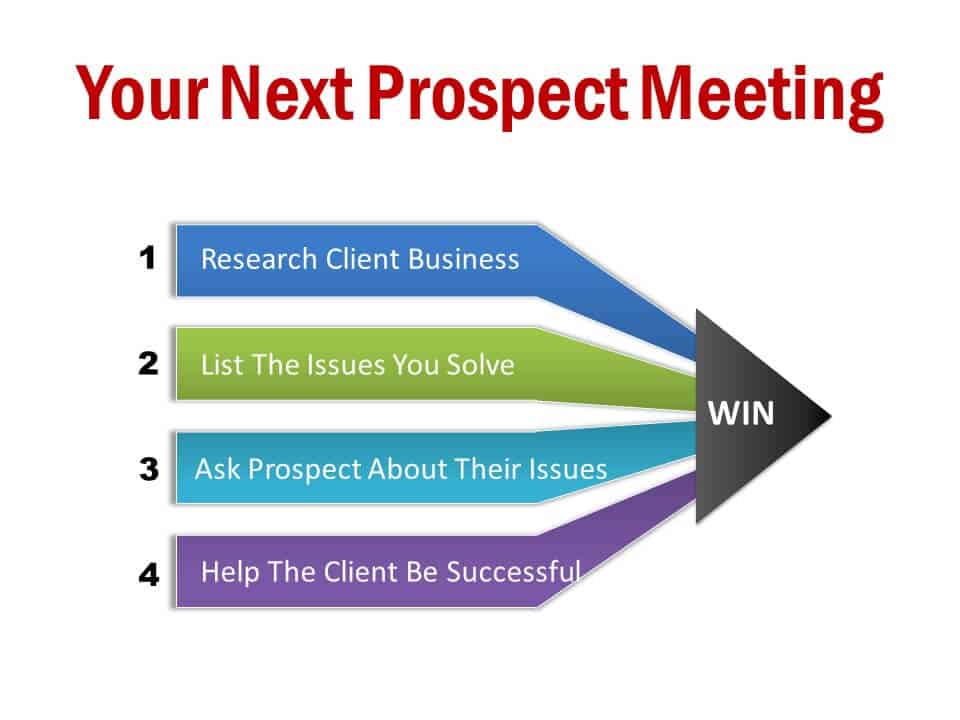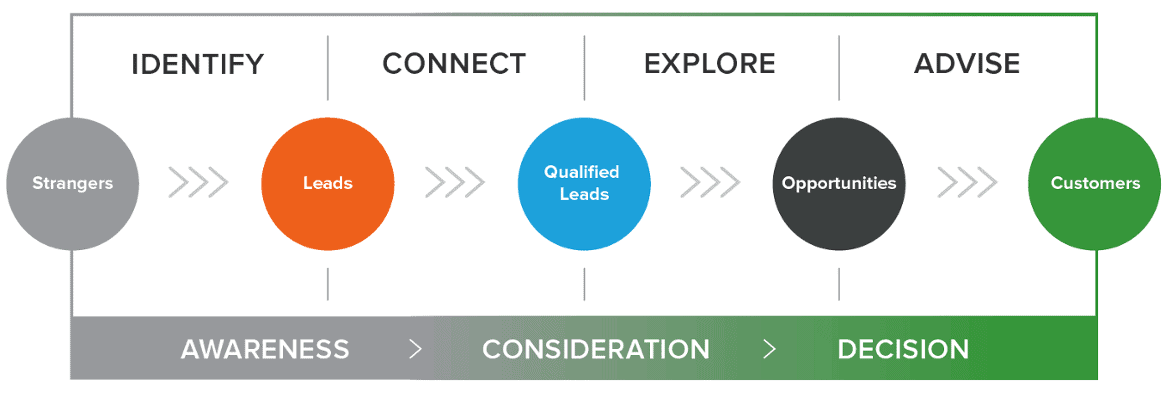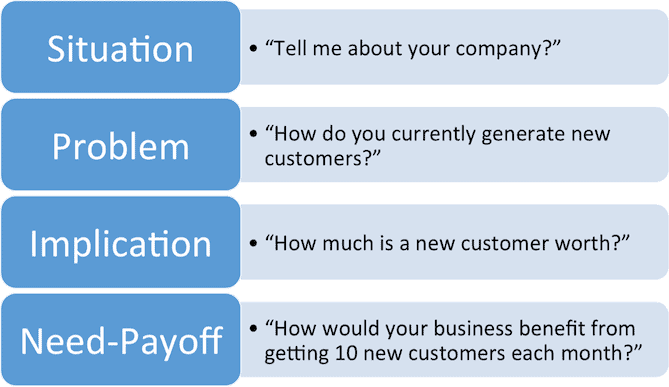Selling is the end of a process. The way you organise your sales processes has a direct impact on the conversion rate from prospects to customers and therefore on the sales performance of your company. The most successful companies are those that manage to continuously evolve and modernise their sales processes.
What are the main stages of a B2B sales process? What are the methodologies that allow you to evolve your commercial approach and achieve greater operational efficiency? How can you build a sales process improvement approach? We answer your questions.
Sommaire
What is a business process?
Let’s start by defining what we are talking about. A sales process refers to the series of steps from prospect identification to closing the sale. It is the actual process used by the company’s sales people to acquire new customers. Each step is an activity in its own right, using its own techniques and methodologies. Here are the classic stages of a sales process.
#1 Prospecting
Prospecting is the activity that consists of identifying prospects, i.e. individuals or companies likely to be interested in your products. In its prospecting work, the company can use several channels and media: social networks (in particular LinkedIn, in a B2B context), email, the telephone, conferences and events, internet searches, etc. The company can also prospect among its existing customers, asking them if they know people who might be interested in its products.
Before any prospecting work, sales representatives must have acquired a perfect knowledge of the products marketed, the target clientele (personas), the sector of activity, the competition, etc.
To become more efficient on the prospecting part, discover the articles we have published on the subject:
#2 The “connection
The second generic step is to contact the identified prospects to collect information about them, identify their needs, challenges, objectives and sort them according to their value to the company. This step is usually done through a phone call, but digital tools can also be used or a face-to-face meeting can be arranged.
#3 Research
As prospects move through the pipeline, the company should seek to learn more about them in order to build a more personal relationship with them and be able to offer them targeted products. The more you know about your prospects, the better you can offer them tailored solutions, the more likely you are to turn them into customers.
During this stage, the salesperson may need to contact other people in the prospect’s company to better understand its business and objectives. Some say that the salesperson, in the end, should know more about the company than the prospect himself.
#4 The product presentation (the pitch)
This is obviously an essential step. There comes a time when the salesperson has to present the products and services offered. This is a very time-consuming stage. This is why this stage occurs fairly late in the sales process and is only carried out on well-qualified prospects.
To be effective, the presentation must be personalised, based on the needs and problems of the prospect and take into account any objections. For this stage, the salesperson can be accompanied by colleagues (engineers, product managers, etc.) to answer the prospect’s more technical questions.
#5 Closing the sale
This stage refers to all the activities carried out at the very end of the sales process to get the prospect to buy. The nature of the activities and methods deployed vary greatly from one company to another: quotation, sales proposal, negotiations, meetings with decision-makers, etc.
Selling is what all salespeople work for. It is the ultimate goal. The salesperson usually receives a commission on the sales price negotiated with the customer. Once the sale is completed, the customer account is passed from the sales person to a customer success manager.
To be effective, a business process must be :
- Customer-centric. Buyers have become more powerful, as they are much more informed than in the past and have many options before them. You have to integrate this reality into your processes. You should not insist on the intrinsic qualities of your products but on their adequacy with the needs, challenges and objectives of your prospects.
- Clearly defined. To be effective, every step and element of the business process must be clearly understood by all stakeholders.
- Reproducible. Sales staff must be able to reproduce the different steps of the sales process in their logical sequence without difficulty.
- Predictable. The flows and results of your business process should follow a predictable pattern.
- Focused on well-definedobjectives upstream: generating more revenue for the company, increasing the productivity of sales staff, etc.
- Measurable. The activities and other elements that make up your business process must be quantifiable to make performance management possible.
- Scalable. The business process must be flexible in order to adapt to changes in your organisation, to the evolution of the technologies used and the operations implemented.
Discover 30+ tools to automate your sales prospecting.
Sales methodologies to make your sales processes more efficient
Sales processes can be optimised by the implementation of sales methodologies by your sales staff. The sales methodologies that we are going to present to you, which are standardised methodologies of Anglo-Saxon origin, designate relational approaches intended to optimise the work of the sales force in its various daily activities.
Here are the 11 most popular sales methodologies:
- Challenger Sale
- Conceptual Selling
- Consultative Selling
- Customer-centric Selling
- Inbound Selling
- MEDDIC
- N.E.A.T Selling
- SNAP Selling
- Solution Selling
- SPIN Selling
- Value Selling Framework
#1 Challenger Sale
The “Challenger Sale” methodology was theorised in 2011 by a certain Matthew Dixon, who categorised in a book salespeople into 5 classes:
- Relationship builders
- The hard workers
- Lone wolves
- Reactive solvers
- The challengers
According to Matthew Dixon, challengers are the most successful, especially in a B2B context. Challengers are the salespeople who first make prospects aware of the changes needed in their organisation and the opportunities that exist, before presenting effective, customised solutions.
#2 Conceptual Selling
This methodology consists of rethinking the sales process as a process that consists of convincing a prospect to buy a concept (an expected result) rather than a product. The salesperson’s objective – through empathy, active listening and questioning – is to uncover what the prospect wants, the solution that seems most acceptable to him or her, the state he or she wishes to achieve. It is then up to the salesperson to propose solutions or present the benefits of their product in line with the prospect’s conception.
#3 Consultative Selling
This is an evolution of the “solution selling” methodology made popular in the 1980s. In this sales approach, the salesperson assumes the role of expert advisor. They do not seek to sell their product but to help their prospect by giving advice, which implies starting by taking an in-depth interest in them. The aim is to gain the prospect’s trust and authority so that he or she will want to buy from the sales consultant.

#4 Customer-Centric Selling
As the name suggests, this method consists of first focusing on the challenges, needs, expectations and objectives of the prospect. As in the previous method, the aim is to play the role of advisor before taking on any sales pitch. In this approach, processes and activities are adapted to fit the prospect’s schedule, situation and various constraints. Rather than making presentation pitches, salespeople use conversation to make the prospect aware of solutions that could help them solve their challenges.
#5 Inbound Selling
This is a fairly recent methodology, linked to the development of the internet. This method consists of using the resources of content marketing to attract customers to you rather than going to them. It involves creating high-value content (blog articles, infographics, white papers, ebooks, webinars, etc.) that leads prospects to become aware of their needs and to contact the company. To go further, we invite you to discover the article dedicated to the subject on La Fabrique du Net: “Inbound vs Oubound marketing – Which marketing strategy for your project?“.

#6 MEDDIC
MEDDIC is an acronym for Metrics, EconomicBuyer, DecisionCriteria, DecisionProcess, IdentifyPain, Champion. It is a very well-defined framework for implementing a sales process driven by technologies, metrics and data. This methodology is mainly used for the prospecting stage and the qualification of leads. We refer you to it to go further: The complete guide to lead qualification.
#7 N.E.A.T Selling
This is again an acronym for Need, EconomicImpact, Accessto Authority and Timeline. The idea is to start by identifying the fundamental needs of the prospects by looking at their challenges, before focusing on the economic benefits to be expected from the implementation of the proposed solution, contacting the various decision-makers to convince them one by one of the interest of the solution and setting a customised decision-making agenda.
#8 SNAP Selling
Another acronym, for Simple, iNvaluable, Alignedand Priority. This method consists of speeding up the sales process by assuming that the potential buyer is a very busy person. It is about getting straight to the point and focusing on the essentials, on the priorities expressed by the prospect.
#9 Solution Selling
This method, which dates back to the 1970s, goes against the traditional product-centred approach. Instead, it focuses on the benefits, impact and relevance of the customised solutions proposed. It is about presenting the product not for what it is (its characteristics) but as THE solution to the problems faced by the prospect. This implies acquiring in-depth knowledge of the needs and expectations of the prospects, and precisely qualifying the current situation and the problem encountered.
#10 SPIN Selling
SPIN is an acronym that summarises the four basic questions a salesperson should ask his or her prospects: Situation, Problem, Implication, Need-Payoff. The aim is 1/ to assess the situation experienced by the prospect, 2/ to isolate the fundamental problem that needs to be solved, 3/ to highlight the consequences of not solving the problem, 4/ to guide the prospect in solving the problem.

#11 Value Selling Framework
This methodology focuses on qualifying leads and assessing their value. The objective is to enable salespeople to become more efficient by focusing their efforts on those leads that are likely to generate the most value for the company. This methodology encourages salespeople to ask the right questions, to articulate the value of the product and the need of the prospects and to personalise the approach and the solutions offered.
These different methodologies are all tools that can help you change your business approach and improve the efficiency of your processes. We advise you to pick good practices adapted to your context from different methodologies rather than focusing on one single methodology.
Let’s look at how to set up effective business processes.
Discover the top 10 trends in the world of B2B CRM software.
How to implement a business process improvement approach?
Do you want to change your business processes? Here are the steps we recommend you take.
#1 Observe your sales people and their working methods
Take the last 5 or 10 closed sales. Identify the main steps in the sales process that led to a successful sale and the different points of contact with the customer. Assess the time it took to complete the different steps.
These analyses will allow you to diagnose your current sales practices, identify blockages, actions that have helped prospects move through the conversion funnel and areas for improvement. Before changing anything, you need to understand your existing sales processes.
#2 List the typical steps in your sales process
Every sales process is different. The process may differ from one prospect to another and according to the nature of the products sold. However, you can probably identify a generic pattern, including some or all of the steps listed above in our article.
Mapping your business process is an important step. It gives you a clear picture of existing practices.
#3 Identify the actions that move the prospect from one stage to the next
For each of the stages you have defined, you should try to understand what causes a prospect to move from one stage to the next. In general, the cause is to be found in the prospect’s actions rather than in the salesperson’s perception. Ask yourself questions like:
- In the course of his research, did the salesperson eventually identify a pain point that motivated the prospect to make a telephone appointment?
- During the pitch, did the prospect raise objections that blocked the sale or did the presentation quickly move on to the next stage?
- When the salespeople made their presentation, did the prospects immediately say yes? In cases where the answer was yes, how did the salespeople do it? How did they construct their sales pitch?
- …/…
Find out how to set up and promote webinars to generate more leads.
#4 Iterate
Building a sales process is a never-ending task. In the first few weeks and months of implementing your improvement process, you will inevitably want to test things out, based on feedback from your sales people.
Your sales process will most likely evolve as your salespeople identify better ways of working and ways to move prospects through the process faster.
#5 Measuring
In a performance improvement approach, measuring is not an option. It is essential. Setting up a reporting system requires the selection of relevant KPIs. Choose KPIs for each stage of your business process.
For example, the number of prospects who moved from step X to step Y during a given period, the average time spent by a prospect in each step, the percentage of prospects who bought after the presentation, the percentage of prospects who requested a demonstration after a phone call, etc. Monitoring these indicators will enable you to gradually improve your sales processes.
To conclude, never forget that a commercial process, however well-tried, is not destined to remain identical to itself over time. It will necessarily have to evolve, to adapt to changes in technology, practices, customer behaviour, etc.






